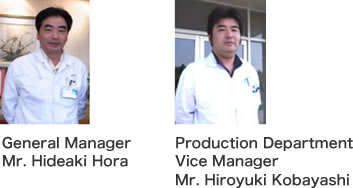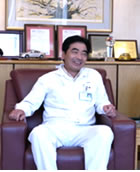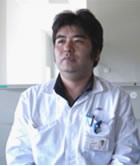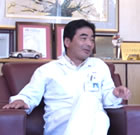cadmeister-thai@uelthai.co.th


…(APAC) was established in October, 2001. Since then, it has enabled the parent company to operate business globally in China, Thailand, USA, Canada, England and Brazil. The company serves the parent company as a critical hub capable of manufacturing and supplying high-quality and high-performance automobile frame components on the basis of state-of-the-art technologies and equipment that have been imported. The entirety of the company has continued to create a monolithic unity for business operations under the philosophy that has guided them since its establishment. It purports to aim to respond smoothly to the expectations of customers in the world and local communities, as well as shareholders through the world’s top level QCD capabilities to be achieved mainly in the Chinese market.

Mr. Hora decided to introduce CADmeister, saying, "APAC, owned entirely by Japanese investment, advanced into the Chinese market in 2001 at the request of Guangqi Honda Automobile Co., Ltd. APAC procured everything including necessary dies and welding equipment and jigs from Japan. The company performed nothing other than mass production for the three years. Since then, against the backdrop of a boosted car production, an automated mass production was enabled during the period of 2005 through 2007 as a result of capital investment embarked on by APAC.
The automobile industry advanced rapidly in China in 2005 and thereafter, and many major Japanese manufacturers entered the Guangzhou market. As a result, manufacturers in the auto industry engaged in fiercer competition. We also needed to procure dies locally and reduce costs. Thus, we began considerations regarding the establishment of die department in 2006.
The problem was how to enable novice Chinese employees to manufacture dies. We decided not to depend on individual skills. We thought that a die business could not exist unless dies are manufactured on the basis of data. Fortunately, our parent company in Japan utilized CADmeister. The key reason for using CADmeister was that we could benefit from using the same mechanism as is. A local support extendable by UEL was part of our consideration, as well."

The same die quality production at the same speed as in Japan has become enabled.
APAC currently utilizes the CADmeister modules such as Form, Press-SIM, FMCAM, Die-Stacker, and 3D Laser.Mr. Kobayashi explains the use of CADmeister functions, saying, "We use CADmeister for modelling. Due to a recent increase in high tensile steel products, the bottleneck for modelling is anticipating deformation amounts. The Form module has significantly helped us to perform anticipated deformation modelling.
FMCAM enables us to design and manufacture foamed styrol dies. We use FMCAM for the phases from form milling data creation to fabrication and finishing. We outsource the production of casting dies before performing the first-stage processing through the use of Die-Stacker.
Die-Stacker that has been in use since our establishment in China benefits us in enabling a smooth performance of unmanned machining. We perform a 3D laser machining of Trim Panels in order to confirm Blank Deployment Lines and Trim Development Lines. Optional functions such as 3D LASER in conjunction with CADmeister benefit us by preventing data re-working when data is exchanged.
Our die business, released in the same environment as our parent company, started so smoothly. It has enabled us to create dies of comparable quality at comparable speed as in Japan."

Mr. Hora said, "Competition in the Chinese die market is expected to be intensified due to local manufacturers capable of inexpensive operations. We must think of die businesses from a global point of view without being bound to the Chinese market. I foresee that Chinese manufacturers will play a role of providing dies to the rest of the world. I think that the skills of engineers have been compromised due to the focus on business priorities. They need to be strengthened.
It would be appreciated if UEL would share with us expertise about die designs and methods related to human resources development. Also, we would like to have a set of functions which enables quick quality analyses and use these results for creating optimum types of dies."
Furthermore, Mr. Hora shared hard experiences that he suffered since he was sent over to China, and his vision for the future.
"When I came to China in 2005, I was challenged by various types of issues including matters that could not be expected in Japan. For example, the power supply available to us was about half as much as in Japan. Also, I was not accustomed to a climate of high temperature and humidity. Above all, my most serious concern was if dies can be created by amateurs.
Having said that, I have witnessed production technologies from wooden casting to modern manufacturing. I'm well versed in operating processes and channels for acquiring necessary information. My personal relationships of trust that have been created in Japan have enabled me to stand as I am. I would like to strengthen our capability to supply dies in order to secure our viability.
Furthermore, I have been aware of a distinctive issue for the past few years. I have often asked myself if having novice employees use the latest systems contributes to authentic development of human resources. Their use of systems should not be referred to as work but as menial tasks. The employees have come to think that their work simply involves using a laser scanning system, measuring a product, and printing out a color map. They have not had the experience of seeing and touching actual products that they conceptualized.
I would like to keep in mind the origin of manufacturing while aiming at globalization of our business. I would like to use IT systems as tools to serve manufacturing. I would like to share this philosophy with my employees and see them use the tools."

Interviewed in January 2011
*** The company names and product names described herein are trademarks or registered trademarks of their respective owners.
*** The names of local autonomous bodies, companies and individuals were given in the interview.

UEL (Thailand) Co.,Ltd.